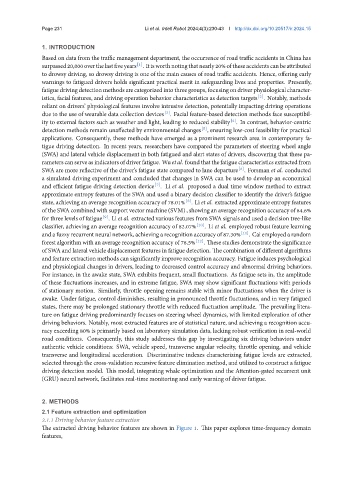Page 171 - Read Online
P. 171
Page 231 Li et al. Intell Robot 2024;4(3):230-43 I http://dx.doi.org/10.20517/ir.2024.15
1. INTRODUCTION
Based on data from the traffic management department, the occurrence of road traffic accidents in China has
[1]
surpassed20,000overthelastfiveyears . Itisworthnotingthatnearly20%oftheseaccidentscanbeattributed
to drowsy driving, so drowsy driving is one of the main causes of road traffic accidents. Hence, offering early
warnings to fatigued drivers holds significant practical merit in safeguarding lives and properties. Presently,
fatiguedrivingdetectionmethodsarecategorizedintothreegroups, focusingondriverphysiologicalcharacter-
[2]
istics, facial features, and driving operation behavior characteristics as detection targets . Notably, methods
reliant on drivers’ physiological features involve intrusive detection, potentially impacting driving operations
[3]
due to the use of wearable data collection devices . Facial feature-based detection methods face susceptibil-
[4]
ity to external factors such as weather and light, leading to reduced stability . In contrast, behavior-centric
[5]
detection methods remain unaffected by environmental changes , ensuring low-cost feasibility for practical
applications. Consequently, these methods have emerged as a prominent research area in contemporary fa-
tigue driving detection. In recent years, researchers have compared the parameters of steering wheel angle
(SWA) and lateral vehicle displacement in both fatigued and alert states of drivers, discovering that these pa-
rameterscanserveasindicatorsofdriverfatigue. Wuetal. foundthatthefatiguecharacteristicsextractedfrom
[6]
SWA are more reflective of the driver’s fatigue state compared to lane departure . Forsman et al. conducted
a simulated driving experiment and concluded that changes in SWA can be used to develop an economical
[7]
and efficient fatigue driving detection device . Li et al. proposed a dual time window method to extract
approximate entropy features of the SWA and used a binary decision classifier to identify the driver’s fatigue
[8]
state, achieving an average recognition accuracy of 78.01% . Li et al. extracted approximate entropy features
of the SWA combined with support vector machine (SVM) , showing an average recognition accuracy of 84.6%
[9]
for three levels of fatigue . Li et al. extracted various features from SWA signals and used a decision tree-like
classifier, achieving an average recognition accuracy of 82.07% [10] . Li et al. employed robust feature learning
and a fuzzy recurrent neural network, achieving a recognition accuracy of 87.30% [11] . Cai employed a random
forest algorithm with an average recognition accuracy of 78.5% [12] . These studies demonstrate the significance
of SWA and lateral vehicle displacement features in fatigue detection. The combination of different algorithms
and feature extraction methods can significantly improve recognition accuracy. Fatigue induces psychological
and physiological changes in drivers, leading to decreased control accuracy and abnormal driving behaviors.
For instance, in the awake state, SWA exhibits frequent, small fluctuations. As fatigue sets in, the amplitude
of these fluctuations increases, and in extreme fatigue, SWA may show significant fluctuations with periods
of stationary motion. Similarly, throttle opening remains stable with minor fluctuations when the driver is
awake. Under fatigue, control diminishes, resulting in pronounced throttle fluctuations, and in very fatigued
states, there may be prolonged stationary throttle with reduced fluctuation amplitude. The prevailing litera-
ture on fatigue driving predominantly focuses on steering wheel dynamics, with limited exploration of other
driving behaviors. Notably, most extracted features are of statistical nature, and achieving a recognition accu-
racy exceeding 80% is primarily based on laboratory simulation data, lacking robust verification in real-world
road conditions. Consequently, this study addresses this gap by investigating six driving behaviors under
authentic vehicle conditions: SWA, vehicle speed, transverse angular velocity, throttle opening, and vehicle
transverse and longitudinal acceleration. Discriminative indexes characterizing fatigue levels are extracted,
selected through the cross-validation recursive feature elimination method, and utilized to construct a fatigue
driving detection model. This model, integrating whale optimization and the Attention-gated recurrent unit
(GRU) neural network, facilitates real-time monitoring and early warning of driver fatigue.
2. METHODS
2.1 Feature extraction and optimization
2.1.1 Driving behavior feature extraction
The extracted driving behavior features are shown in Figure 1. This paper explores time-frequency domain
features,

